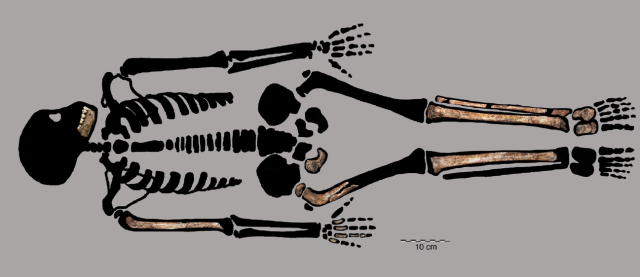A Homo naledi childs skeleton could shed some light on the evolutionary origins of our own species lengthy childhoods. Humans take much longer to grow up than other great apes, which may be related to our larger brains and more complex cognitive skills. Anthropologists are still trying to understand exactly when and how that reality came about. To do so, theyve been working with juvenile skeletons from just a handful of species besides our own: Neanderthals, Homo erectus, Australopithecus afarensis, A. sediba. But now they can also look at Homo naledi.
In 2013 and 2014, paleoanthropologists unearthed the partial skeleton of a Homo naledi child dating from 335,000 to 226,000 years ago. Now called DH7, the skeleton has most of a left leg with the bones still articulated—even several of the tarsals, the small bones that make up the ankle. The bones also included a right thighbone (femur) and hipbone (ischium), a right arm, and part of a lower right jaw and a few teeth. The shafts of the long bones hadnt completely fused with their ends, or epiphyses, which is a sign that the young hominin was still growing when they died.
Its hard to say exactly how old DH7 was, though, since we dont know how quickly Homo naledi children matured. If child development was fairly quick, like in earlier hominin species, then DH7 was probably between eight and 11 years old. But if Homo naledi children developed more slowly, like Neanderthals and modern humans, the bones could look the same at 11 to 15 years old.
Interestingly, DH 7 was at about the same stage of development (if not the same age in years) as a 1.6 million-year-old Homo erectus child from Lake Turkana, Kenya, and a 1.98 million-year-old A. sediba child from Malapa Cave, South Africa. It's impossible not to wonder what these three adolescents might have had in common, and how they might have differed, if they hadn't been separated by hundreds of millennia of time and evolution.
Piecing together an ancient puzzle
Once anthropologist Debra Bolter and her colleagues found the articulated left leg, they went looking through the Dinaledi Chamber collection for other bones at about the same stage of development that might have belonged to the same individual. The bones they selected had to have been found nearby, look like they were at about the same stature and age at death as DH7, and not duplicate pieces already found. It was a bit like rummaging through a box of puzzle pieces for things that fit the same part of an image. They found the right femur, a right ischium, a right upper arm bone (humerus), part of a right lower jawbone (mandible), and some fragments of hand bones (metacarpals).
And there may be more of DH7 left to find. Bolter and her colleagues aren't yet sure how deep the sediment at the base of Dinaledi Chamber is or how many more fossil bones it might hold. "Consequently, we cannot predict what other remains of this individual may yet be recovered," they wrote.

DH7s wisdom teeth hadnt grown in yet; in modern humans, that happens in the late teens or early 20s for most people. Meanwhile, the epiphyses on the ischium and the ends of the femur and shin bone (tibia) were well-developed but hadnt yet fused—in other words, DH7 wasnt a very young child but was definitely still growing. If anthropologists were looking at a skeleton from our species, theyd have said the child was between 11 and 15 years old.
Thats the challenge, though. We know how long it takes a human child to reach that stage of growth. We even more or less know the same thing for H. erectus; anthropologists counted layers of enamel in teeth from the 1.6 million-year-old skeleton mentioned above, and that one turned out to have been between eight and nine years old at death. But we dont know how long that kind of growth took for Homo naledi children.
Teeth tell (part of) the tale
The best clue we have is DH7's teeth. In our species, the adult premolars all grow in before the second molars show up. But in older hominins like A. sediba and H. erectus, thatRead More – Source
[contf] [contfnew] 
arstechnica
[contfnewc] [contfnewc]







